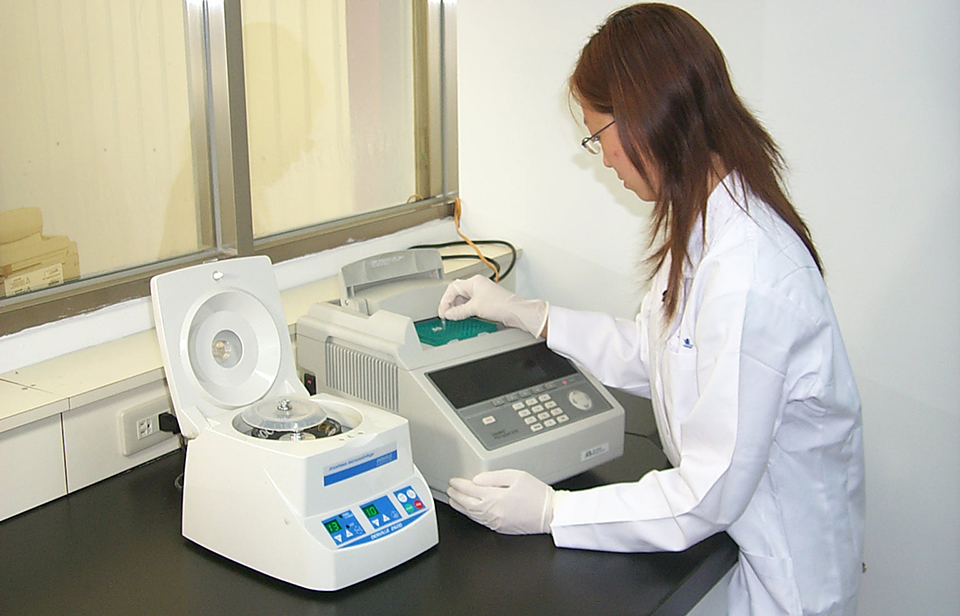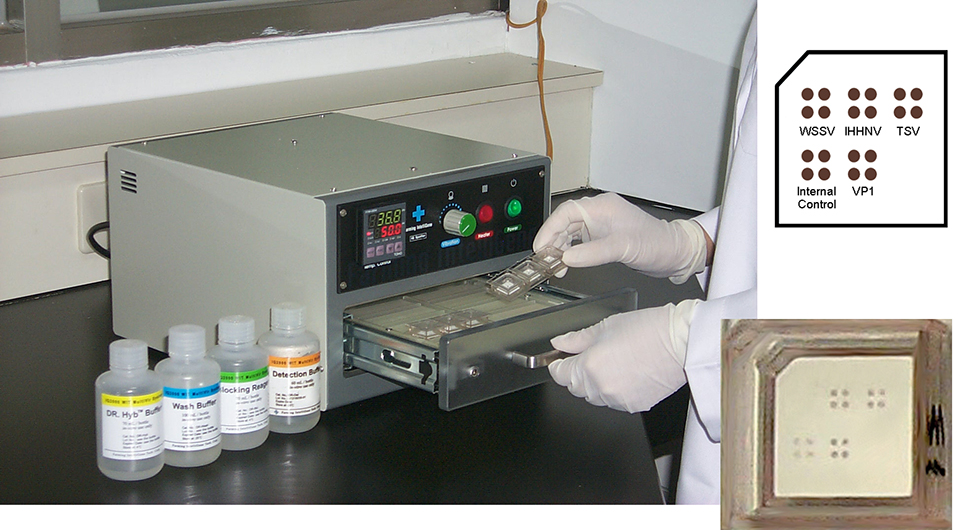Understanding of shrimp biology and target pathogens is crucial

After years of research and experience, the shrimp-farming industry has established production systems that prevent or at least reduce infectious disease risks. The systems are built upon the establishment of specific pathogen-free (SPF) animals and a biosecure farming environment. Both approaches require the absence of pathogens and rely heavily on the implemention of effective diagnosis systems to ensure the systems work properly.
Polymerase chain reaction
In recent years, rapid advancements in biotechnology and microbiology have provided numerous innovative options in diagnostic tools for viral diseases. Among them, polymerase chain reaction (PCR)-based detection has developed into the most popular choice, due to its high degrees of sensitivity and specificity. What’s more, PCR-based diagnostic reagents for the major viruses that significantly affect shrimp production – White Spot Syndrome Virus, Yellow Head Virus, Taura Syndrome Virus, Infectious Hypodermal and Hematopoietic Necrosis Virus, Gill-Associated Virus, Monodon Baculovirus, and Hepatopancreatic Parvolike Virus – are all available commercially.
Presently, PCR-based detection systems are applied to three main areas in the shrimp-farming industry:
- The prevention of disease outbreaks during the production cycle, especially in screenings of broodstock and fry.
- The establishment of founding stocks for SPF shrimp domestication and monitoring of any subsequent viral infections.
- The screening of shrimp stock, postlarvae, or fresh-frozen products for the presence of viral pathogens in quarantine services.
Further detection needs
While PCR is a very useful method, its current technology does not fulfill several important testing needs.
Simple on-site testing
Reliable PCR diagnoses are sometimes difficult to obtain due to the unavailability of equipment or skilled technicians. For example, most small-scale farmers, who routinely purchase broodstock or postlarvae from outside sources, generally do not have the capacity to set up their own PCR labs, and must rely on services provided by professional labs. However, in some cases, such labs are not reliable or easily available. Simple and reliable on-site tests that farmers can perform by themselves could help meet many testing needs.
While fast, conventional rapid tests usually were designed based on immunology. Antibodies and immuno-based detection kits in the rapid test format are available for viruses such as WSSV, YHV, and TSV. However, the best commercial immuno-based technology is 1,000-10,000 times less sensitive than nested-PCR. Rapid tests are helpful in confirming the presence of disease in heavily infected shrimp, but not reliable for detecting low-level infections or carriers. Nucleic-acid direct hybridization technology has similar sensitivity limitations.
Large-scale, multiviral detection
In other circumstances, multiviral diagnostic results may be required in a limited time frame, such as in quarantine services for importing/exporting operations or SPF animal production facilities.
New detection technology
Isothermal nucleic acid amplification

A review of the latest detection technologies based on biosciences will find that various instrument-free extraction procedures, isothermal amplification strategies, and instrument-free data assay procedures are all becoming approachable. Isothermal amplification is particularly interesting because all its reactions are carried out at a fixed temperature. It eliminates the need for the thermocycler, expensive equipment that multiplies DNA in PCR systems through repeated DNA denaturation, and primer annealing and elongation.
Several isothermal amplification strategies, including nucleic acid sequence-based amplification, three-way junction amplification, and rolling circle amplification, have become available recently. Like PCR, these technologies have the power to specifically amplify nucleic acid signals, and are hence potentially capable of detecting viral pathogens at levels of sensitivity similar to nested PCR.
Combining these isothermal amplification technologies with simple nucleic acid extraction procedures, it is possible to create an equipment-free diagnostic system with high degrees of sensitivity and specificity suitable for on-site applications. Detection kits for WSSV, TSV, and IHHNV that use the system are expected to be on the market within about six months.
Multiviral diagnostic kits
As international trading of broodstock and fry becomes more frequent, and newly emerging viral diseases continue to be identified, multiplex systems that can detect several patho-gens in one single test become more important. A PCR-based multiplex detection system for WSSV and IHHNV has been available for more than two years. However, it was not widely accepted, due to unexpected interactions among primers in the detection process and difficulties in data interpretation.
A new multiplex product that combines a total nucleic acid extraction technique, a sensitive and specific multiplex nested RT-PCR procedure, and a clear-cut biochip assay resolves these problems. The test is capable of simultaneously detecting the three most important viral pathogens for L. vanna-mei: WSSV, IHHNV, and TSV.
An example of the diagnostic results using the biochip system is shown to left. Note that adoption of the low-density biochip simplifies data reading, which is performed simply with the naked eyes. This product is particularly welcomed by the quarantine services and shrimp importers who need to routinely screen for multiple viruses and usually demand the results in a very short time.
Conclusion
No matter how far bioscience and technology advance, the keys to successful diagnostic systems for shrimp viral diseases center on an understanding of shrimp biology and target pathogens. Fortunately, significant progress has recently been made in these areas.
A clearer picture for the development of better strategies to deal with viral diseases, in terms of both diagnosis and cures, may emerge in the near future. For the time being, the application of all available technologies and resources, the establishment of proper standards and regulations by governing authorities, and strict industry adherence to protocols are critical to win the war against shrimp pathogens.
(Editor’s Note: This article was originally published in the August 2003 print edition of the Global Aquaculture Advocate.)
Now that you've finished reading the article ...
… we hope you’ll consider supporting our mission to document the evolution of the global aquaculture industry and share our vast network of contributors’ expansive knowledge every week.
By becoming a Global Seafood Alliance member, you’re ensuring that all of the pre-competitive work we do through member benefits, resources and events can continue. Individual membership costs just $50 a year. GSA individual and corporate members receive complimentary access to a series of GOAL virtual events beginning in April. Join now.
Not a GSA member? Join us.
Authors
-
Chen Su
Vice President
Farming IntelliGene Technology Corp.
No. 2-1, Seventh Road
Taichung Industry Park
Taichung 407, Taiwan, ROC -
Peiyu Lee, Ph.D.
Research and Development Director
Farming IntelliGene Technology Corp.
No. 2-1, Seventh Road
Taichung Industry Park
Taichung 407, Taiwan, ROC
Tagged With
Related Posts

Health & Welfare
Analysis, prevention of NHP in Panama, Ecuador and Peru shrimp farms
Based on histopathology and ultrastructure, the etiology of necrotizing hepatopancreatitis (NHP) in Pacific white shrimp was related to an intracellular bacterium.

Health & Welfare
Biosecurity principles for sustainable production using SPF shrimp
Basic components of biosecurity include knowledge of diseases, adequate detection methods and the use of “clean” shrimp stocks.

Health & Welfare
Developmental transcriptomes from penaeid shrimp
To develop an alternative mechanism for genetic copyright of improved shrimp lines, the authors used a bioinformatics approach to identify germ line genes that could be potentially targeted to ablate the germ line.

Health & Welfare
The unmet promise of pondside PCR
A new generation of technology, portable PCR, offers potential for affordable, immediate, pondside diagnosis in easy-to-use handheld kits. But will it live up to the hype?


